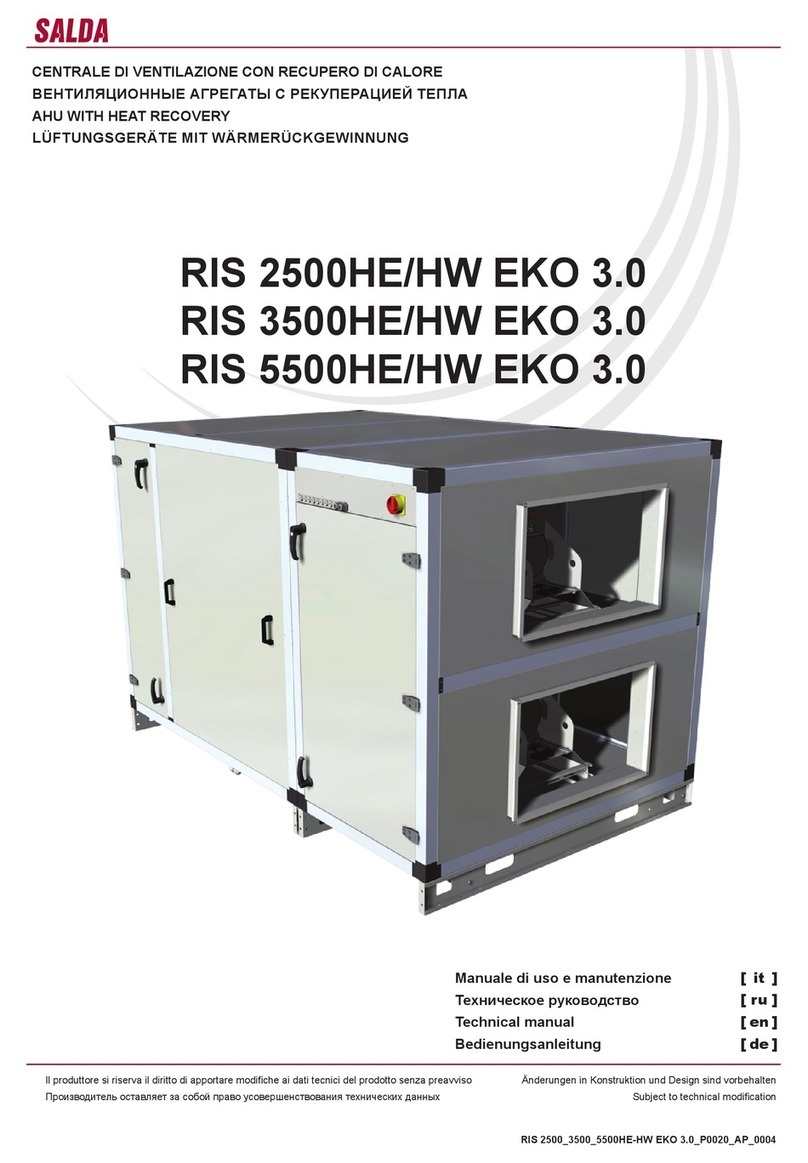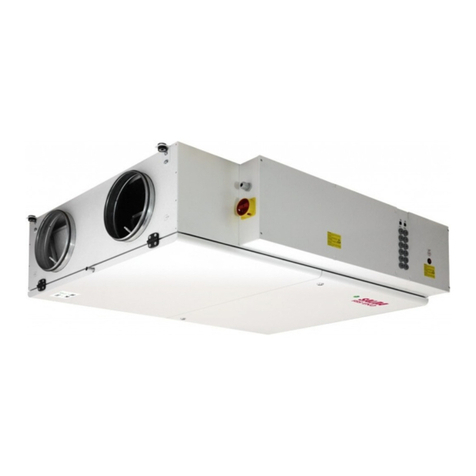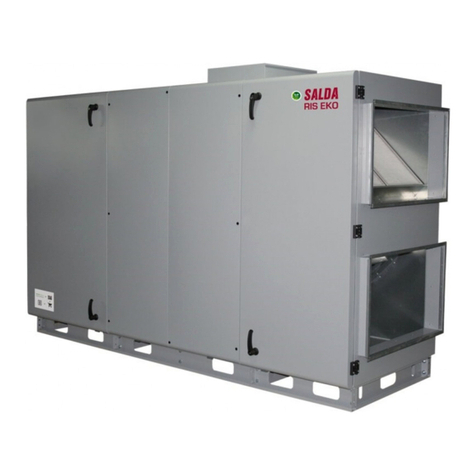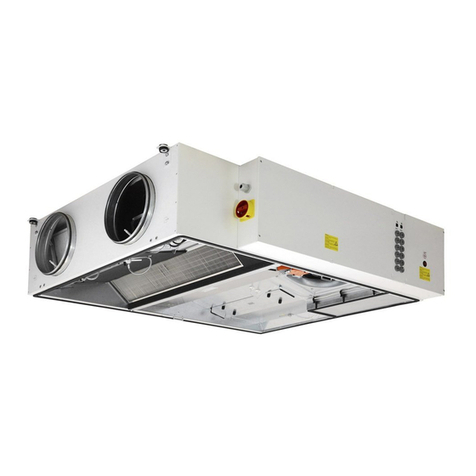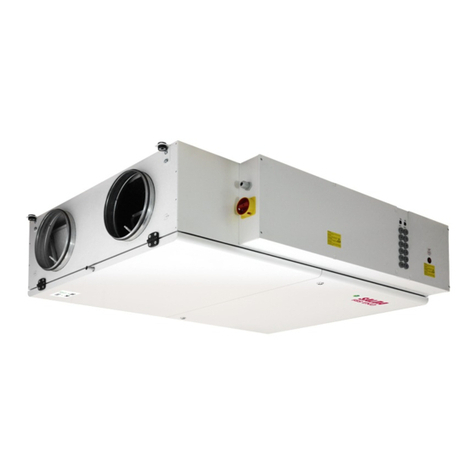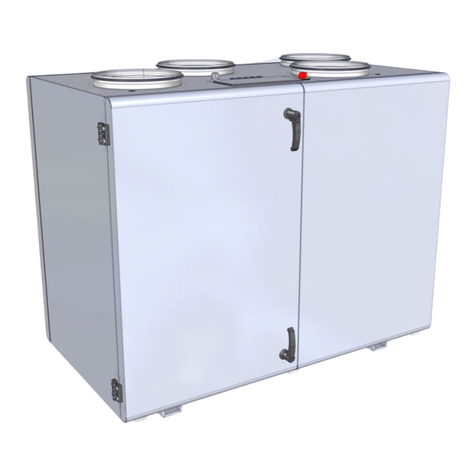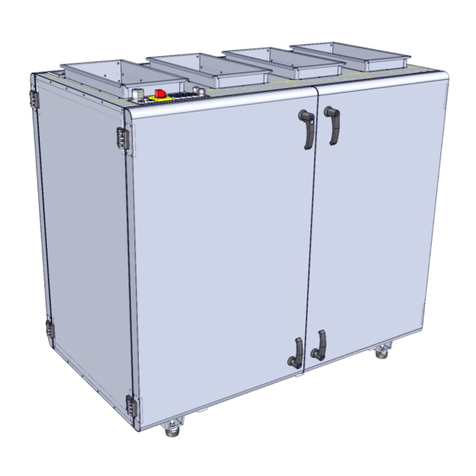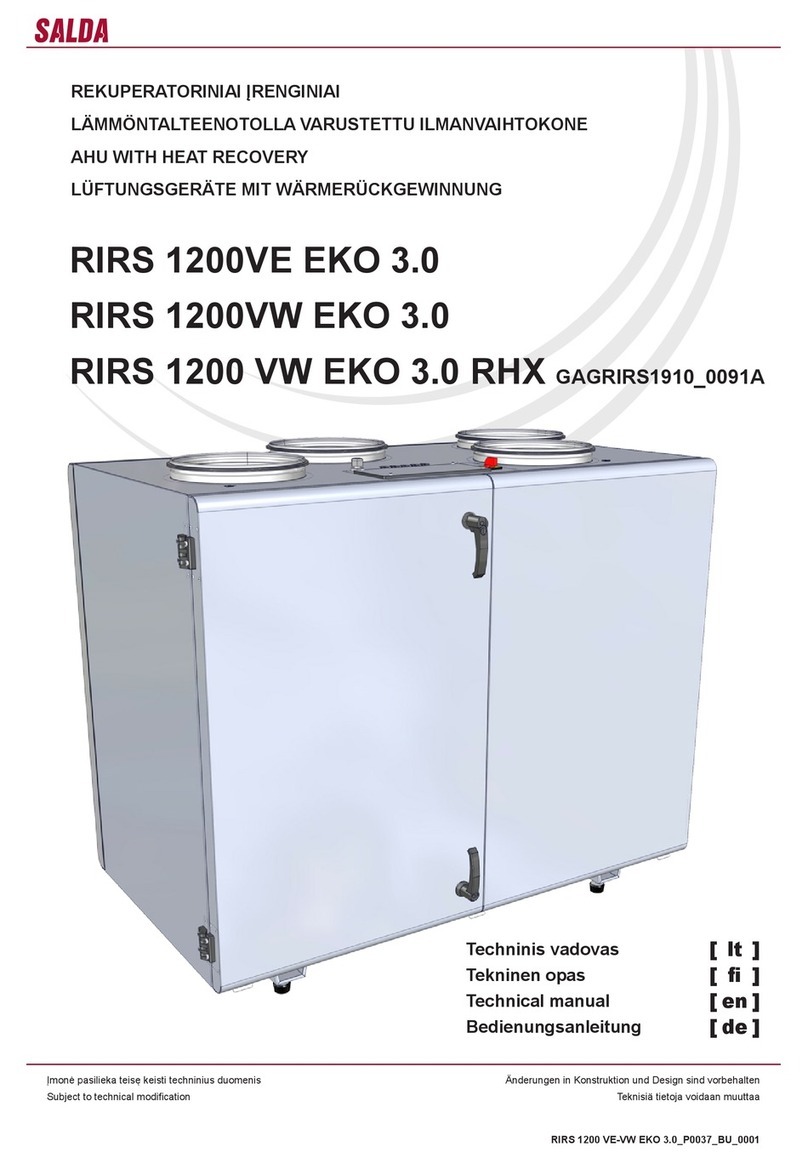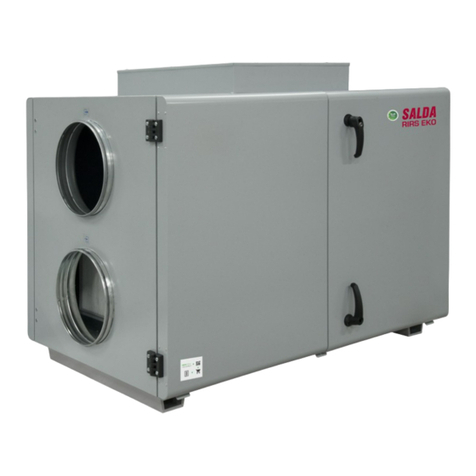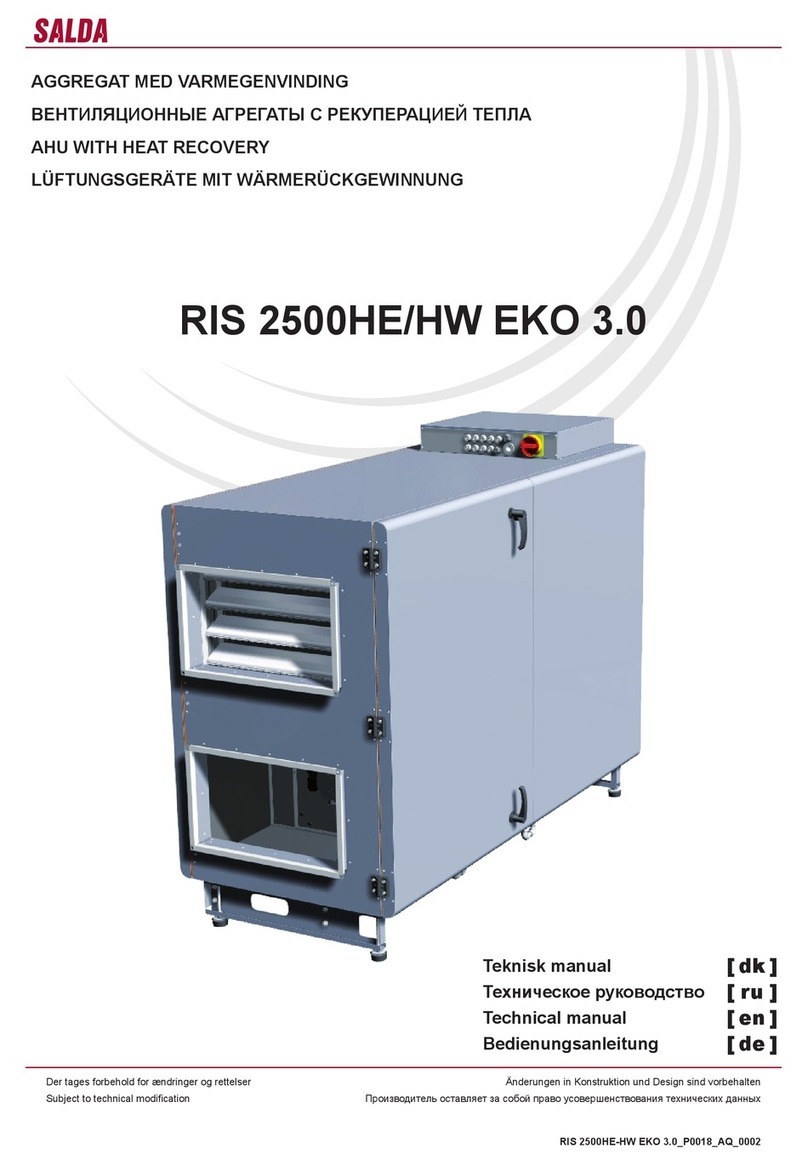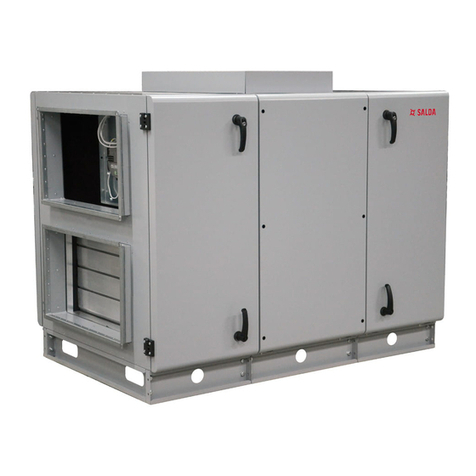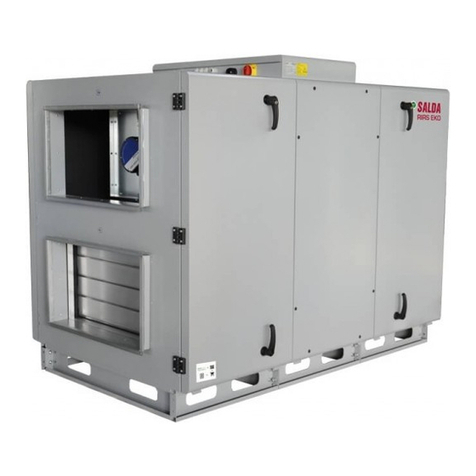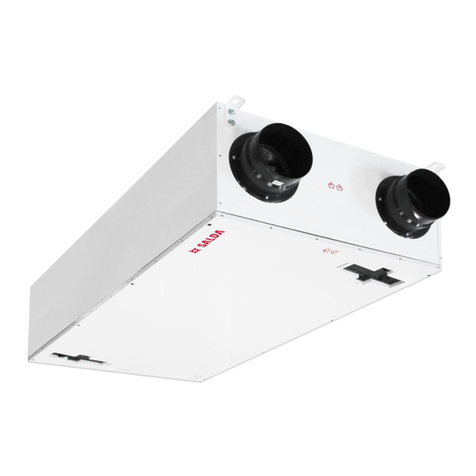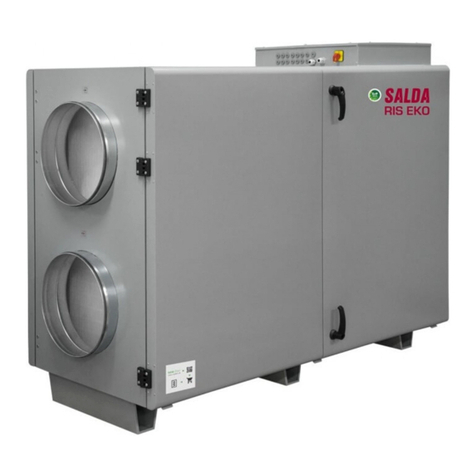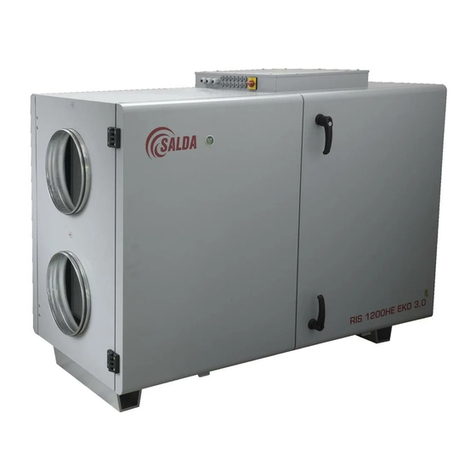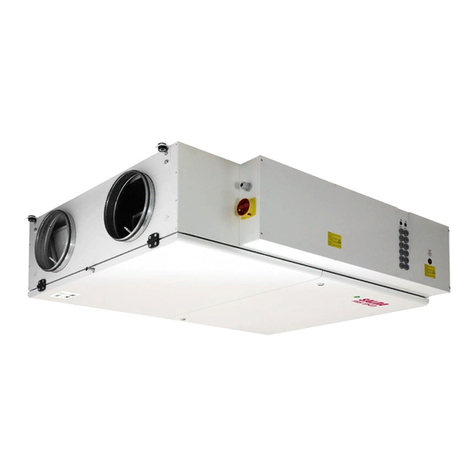
4
RIS 400_700PE/PW EKO 3.0
www.salda.lt
[ lt ] [ it ] [ en ] [ de ]
Visi įrenginiai yra supakuoti gamykloje taip,
kad atlaikytų normalias pervežimo sąlygas.
Išpakavus įrenginį patikrinkite, ar transportuo-
jant jis nebuvo pažeistas. Pažeistus įrenginius
montuoti draužiama!!!
Pakuotė yra tik apsaugos priemonė!
Iškraudami ir sandėliuodami įrenginius, nau-
dokite tinkamą kėlimo įrangą, kad išvengtumė-
te nuostolių ir sužeidimų. Nekelkite įrenginių už
maitinimo laidų, pajungimo dėžučių, oro paė-
mimo arba šalinimo anšų. Venkite sutrenkimų
ir smūginių perkrovų. Įrenginius sandėliuokite
sausoje patalpoje, kur santykinė oro drėgmė
neviršyja 70% (esant +20°C), vidutinė aplinkos
temperatūra - tarp +5°C ir +30°C. Sandėliavimo
vieta turi būti apsaugota nuo purvo ir vandens.
Į sandėliavimo ar montavimo vietą įrenginiai
yra gabenami keltuvais.
Nepatariame sandėliuoti ilgiau nei viene-
rius metus. Sandėliuojant ilgiau nei vienerius
metus, prieš montuojant būtina patikrinti, ar
lengvai sukasi ventiliatorių ir variklių guoliai
(pasukti sparnuotę ranka), ar nėra pažeista
elektrinės grandinės izoliacija ir ar susikaupusi
drėgmė.
L’imballo di tutte le unità garantisce l’integrità
del prodotto in condizioni normali di trasporto.
Dopo aver tolto l’unità dall’imballaggio, con-
trollare che non sia stata danneggiata durante
il trasporto. È assolutamente vietato montare
unità danneggiate!!!
L’imballaggio è solo un mezzo di protezione!
Caricando e scaricando le unità, usare mezzi
di sollevamento appropriati per evitare danni e
lesioni. Non sollevare mai le unità per mezzo
dei cavi di alimentazione, per le scatole di con-
nessione, ange di aspirazione o di espulsione.
Evitare urti o forti sollecitazioni al corpo dell’unità.
Conservare le unità in un locale asciutto in cui
l’umidità relativa non deve superare il 70% (a una
temperatura di +20°C), e la temperatura media
deve essere mantenuta tra i +5°C e +30°C.
Immagazzinare le unità in luoghi asciutti ed al
riparo dall’acqua e dallo sporco.
Le unità devono essere movimentate mediante
un carrello elevatore.
È sconsigliato lo stoccaggio per un periodo
superiore ad un anno. In caso di stoccaggio
per un periodo superiore ad un anno, prima del
montaggio controllare se i cuscinetti dei ventila-
tori e dei motori girano facilmente (far girare la
ventola con una mano), vericare l’integrità del
isolamento del circuito elettrico, controllare che
non vi siano segni di umidità.
All units are packed in the factory to withstand
regular conditions of transportation.
Upon unpacking, check the unit for any dam-
ages caused during transportation. It is forbidden
to install damaged units!!!
The package is only for protection purpose!
While unloading and storing the units, use
suitable lifting equipment to avoid damages and
injuries. Do not lift units by holding on power
supply cables, connection boxes, air intake or
discharge anges. Avoid hits and shock over-
loads. Before installation units must be stored
in a dry room with the relative air humidity not
exceeding 70% (at +20°C) and with the average
ambient temperature ranging between +5°C and
+30°C. The place of storage must be protected
against dirt and water.
The units must be transported to the storage or
installation site using forklifts.
The storage is not recommended for a period
longer than one year. In case of storage longer
than one year, before the installation it is neces-
sary to verify whether the bearings of fans and
motor rotate easily (turn the impeller by hand)
and if the electric circuit insulation is not dam-
aged or the moisture is accumulated.
Alle Geräte sind werksseitig so verpackt,
dass sie den normalen Transportbedingungen
standhalten können.
Nach Auspacken des Gerätes überprüfen Sie,
ob es beim Transport nicht beschädigt wurde.
Beschädigte Geräte dürfen nicht montiert
werden!!!
Die Verpackung ist nur eine Schutzmaßnahme!
Beim Ausladen und Lagern der Geräte verwen-
den Sie geeignete Hebezeuge, um Schäden
und Verletzungen zu vermeiden. Heben Sie die
Geräte nicht an Netzkabeln, Anschlusskästen,
Zu- und Abluftstutzen. Vermeiden Sie Stöße und
Schläge. Lagern Sie die Geräte in einem trocke-
nen Raum, wo die relative Luftfeuchte höchstens
70% (bei +20°C) beträgt und die durchschnittli-
che Umgebungstemperatur zwischen +5°C und
+30°C liegt. Der Lagerort muss vor Schmutz und
Wasser geschützt sein.
An den Lager- bzw. Montageort werden die
Geräte mit Hebezeugen transportiert.
Eine Lagerung länger als ein Jahr ist nicht
empfehlenswert. Bei einer Lagerung länger
als ein Jahr ist vor der Montage unbedingt zu
prüfen, ob die Ventilator- und Motorlager leicht-
gängig sind (Flügelrad mit der Hand drehen),
ob die Isolierung des elektrischen Stromkreises
nicht beschädigt ist und sich keine Feuchtigkeit
angesammelt hat.
- Non usare questo dispositivo per scopi diversi
da quelli previsti.
- Non manomettere e non modicare il dispo-
sitivo. Ciò può provocare guasti meccanici o
funzionali.
- Eettuare il montaggio e i lavori di manuten-
zione indossando abbigliamento e protezioni
adeguate. Prestare attenzione: gli spigoli del
dispositivo e dei suoi componenti possono essere
taglienti e appuntiti.
- Non indossare abiti larghi e non aderenti
che possano essere risucchiati dal ventilatore
in azione.
- Do not use the unit for purposes other than
its’ intended use.
- Do not disassemble or modify the unit in any
way. Doing so may lead to mechanical failure
or injury.
- Use special clothing and be careful while
performing maintenance and repair jobs - the
unit’s and its components edges may be sharp
and cutting.
- Do not wear loose clothing that could be
entangled in to operating unit.
- Do not place ngers or other foreign objects
through inlet or exhaust guards or into con-
- Die Anlage darf nur für den dafür vorgesehenen
Zweck gemäß Bedienungsanleitung verwendet
werden.
- Die Demontage und Montage darf nur gemäß
der Betriebsanleitung vorgenommen werden
(Verletzungsgefahr oder Gefahr mechanischer
Störungen)
- Bei der Montage und Inbetriebnahme muss
Sicherheitskleidung getragen werden. Vorsicht:
die Winkel und Kanten der Anlage und der Kom-
ponenten können scharf sein und Verletzungen
verursachen;
- Bei der Arbeit sollte eng anliegende Kleidung
Rekuperatoriai - tai oro vėdinimo įrenginiai,
kurie valo, šildo ir tiekia šviežią orą. Įrenginiai
paima šilumą iš išmetamo oro ir perduoda jį į
tiekiamą.
• Plokštelinis šilumokaitis, kurio temperatūrinis
našumas iki 90 %.
• Integruota motorizuota apėjimo sklendė („By-
pass“).
• Našūs ir tyliai veikiantys EC ventiliatoriai.
• Žemas SFP (Specic Fan Power) lygis
EN13779 Integruotas saugaus atkirtimo jungi-
klis EN 60204-1:2006) (tik RIS PE EKO 3.0).
• Akustinė ir šiluminė 30mm išorinių sienelių
izoliacija.
• Integruota valdymo automatika, „Plug and
Play“ pajungimas.
• Paneliniai ltrai F7/M5.
• Agregate sumontuoti: TL - šviežio oro tempe-
ratūros jutiklis, TJ - tiekiamo oro temperatūros
jutiklis, TE - šalinamo oro temperatūros jutiklis,
DTJ100.1 - ištraukiamo oro dregmės ir temepe-
ratūros jutiklis.
• Standartiškai tiekiamas su V2 automatikos
valdikliu.
Netinkami naudoti baseinuose, pirtyse ir
kitose panašiose patalpose.
Rekuperatorius negali būti naudojamas
kaip orinis šildytuvas.
Į standartinę pakuotę (be papildomai užsako-
mų priedų) įeina:
1) vėdinimo įrenginys;
2) poveržlė 5 (DIN 440R) - 8 vnt.
3) Raktas - 1 vnt.
4) Amortizacinis padukas - 4 vnt.
5) Spyruoklinė poveržlė - 8 vnt.
6) Varžtas M5x20 - 8 vnt.
7) Pakabinimo kronšteinas - 4 vnt.
8) Skaidri žarna - 1 vnt.
9) Sąvarža - 2 vnt.
10) Tiekiamo oro temperatūros jutiklis (TJ) - 1
vnt.
11) AVS priešužšaliminės apsaugos rinkinys
(kai vandeninis šildytuvas)
I recuperatori di calore sono unità di ventilazio-
ne per il ricambio e la ltrazione dell’aria. Me-
diante lo scambiatore di calore l’energia termica
contenuta nell’aria espulsa viene recuperata e
ceduta all’aria immessa. Essi sono costituiti da:
• Scambiatore di calore a piastre con rendi-
mento termico no al 90%.
• By-pass automatico con valvola motorizzata
integrata.
• Ventilatori EC ad alta ecienza e silenziosità.
• Ventilatori EC ad alta ecienza e silenziosità.
• Basso assorbimento elettrico: SFP (Specic
Fan Power) calcolato secondo EN13779
• Interruttore di sicurezza integrato EN 60204-
1:2006 (solo RIS PE EKO 3.0).
• 30 mm di isolamento acustico e termico
dell’involucro.
• Controllo automatico integrato con , connes-
sione al pannello remoto di tipo „Plug and Play“.
• Filtri piani F7/M5.
• La fornitura include: TL - sensore temperatura
dell’aria esterna, TJ - sensore temperatura aria
immessa, TE - sensore temperatura aria espul-
sa, DTJ100.1 - sensore di umidità e temperatura
sull’aria estratta.
• In versione standard il recuperatore viene
fornito con la logica di tipo V2.
Non adatto all’uso all’interno di piscine,
nelle saune e in altri ambienti simili.
Recuperatore di calore non può essere uti-
lizzato come un riscaldatore dell’aria.
La fornitura standard include (senza accessori
opzionali):
1) dispositivo di ventilazione;
2) Raccordo scarico condensa
3) Staaggio di sostegno
4) Sensore temperatura aria immessa (TJ) 1
pz. (con batteria elettrica)
AHUs are air ventilation devices that clean,
heat and supply fresh air. Units take heat from
exhausted air and transmit it to supply air.
Plate heat exchanger with temperature ef-
ciency up to 90 %.
Integrated motorized by-pass valve.
Ecient and silent EC fans.
Low SFP (Specic Fan Power) level EN13779.
Integrated safety cut-off switch EN 60204-
1:2006. (just RIS PE EKO 3.0).
Acoustic and thermal 30mm insulation of
external walls.
Integrated control automation, Plug and Play
connection.
Panel lters F7/M5.
Package includes: TL - temp. sensor for fresh
air, TJ - temp. sensor for supply air, TE - temp.
sensor for exhaust air, DTJ100.1 - temp. and
humidity sensor for extract air.
As standard, supplied with Ewith automatic
controller V2.
Not suitable for use at swimming pools,
saunas and other similar facilities.
The unit can not be used as an air heater.
Standard package (without optional acces-
sories) includes:
1) Ventilation unit;
2 ) washer (DIN 440R) - 8 pieces
3 ) Key - 1 pc .
4 ) cushion pad - 4 units .
5 ) Spring washer - 8 pieces .
6 ) Screw M5x20 - 8 pieces .
7 ) Suspension bracket - 4 units .
8 ) Transparent hose - 1 pc .
9 ) clamp - 2 pcs .
10) Supply air temperature sensor (TJ) - 1 pc.
11) AVS anti-freeze protection kit (for water
heater)
WRG-Ventilatoren sind Lüftungsgeräte, die
reinigen, erwärmen und liefern frische Luft. Die
Geräte nehmen die Wärme von der Abluft und
übergibt sie der Luft, die geliefert wird.
Plattenwärmeaustauscher, dessen Tempera-
turleistung bis 90 % beträgt.
Integrierter motorisierter Bypass-Klappe.
Leistungsfähige und leise EC-Ventilatoren.
Niedriges SFP-Niveau (Specic Fan Power)
laut EN 13779.
Integrierter Abtrennschalter laut EN 60204-
1:2006. (nur RIS PE EKO 3.0).
Lärm- und Wärmedämmung der 30 mm-
Außenwände.
Integrierte Steuerautomatik, Plug and Play-
Anschluss.
Plattenlter F7/M5.
Im Lieferumfang enthalten: TL- Außenluft-
temperaturfühler, TJ - Zulufttemperaturfühler,
TE - Ablufttemperaturfühler, DTJ100.1 - Ab-
luftfeuchte- und Temperaturfühler.
V2 Automatik-Regler gehört zum seriellen
Lieferumfang.
Nicht für Betrieb in Schwimmbädern, Sau-
nen und ähnlichen Räumen bestimmt.
Das Lüftungsgerät darf für Heizungszwe-
cke nicht verwendet werden.
Zur Standardverpackung (ohne Zubehör, das
zusätzlich bestellt wird) gehören:
1) Lüftungsgerät;
2) scheibe (DIN 440R) - 8 Stück.
3) Key - 1 St .
4) Kissenpolster - 4 Einheiten.
5) Federscheibe - 8 Stück.
6) Schraube M5x20 - 8 Stück.
7) Die Aufhängung - 4 Einheiten.
8) Transparent -Schlauch - 1 St .
9) klemmen - 2 Stk .
10) Zulufttemperaturfühler (TJ) - 1 St .
11) AVS Frostschutz - Kit (für Durchlauferhitzer)
- Nenaudokite šio įrenginio kitiems tikslams, nei
numatyta jo paskirtyje.
- Neardykite ir niekaip nemodikuokite įren-
ginio. Tai gali sukelti mechaninį gedimą ar net
sužeidimą.
- Montuodami ir aptarnaudami įrenginį naudo-
kite specialią darbinę aprangą. Būkite atsargūs
- įrenginio ir jį sudarančiųjų dalių kampai ir briau-
nos gali būti aštrios ir žeidžiančios.
- Šalia įrenginio nedėvėkite plevėsuojančių
drabužių, kuriuos galėtų įtraukti į veikiantį ven-
tiliatorių.
- Nekiškite pirštų ar kitų daiktų į oro paėmimo
